Progress Report 02/08/99
Serious work on my 1976 BMW 2002 began on Friday November 7, 1997. There was much work to be
done on the car, and I decided to work on the powertrain first. I figured it was a good
starting point. After all, after it gets up and running, I can always drive the car to get
other work done as needed.
THE TEARDOWN |
RADITOR |
HEAD |
CYLINDER WALLS |
THE CRANKSHAFT |
THE PISTONS |
THE CONNECTING RODS |
THE TEARDOWN
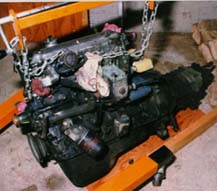
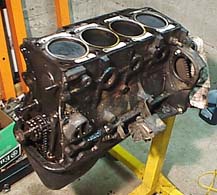
In November 1997, I pulled the engine and transmission together from the 2002.
Not a difficult task at all, even for one person. While unbolting other stuff
from the engine compartment, I noticed the radiator was in bad shape. Once out
of the car, I separated the transmission and began dismantling the engine.
Once out of the car, I was able to clean and examine the outside of the block.
A couple of things struck me as odd. First is that the head was an E12, which
was not correct for a 49-state 1976 2002 (which this car is). The second was
that the s/n of the block did not match the VIN on the car. After enlisting the
help of 2002 email list members, I discovered that the engine is from a '73
2002, and not a '76. The E12 head, therefore is "correct" for this particular
engine When I pulled the cylinder head off, I was able to look down the bores at
the cylinder walls. They looked good, with no major scoring. However, I noticed
something disturbing on cylinder #2. It appeared that a chunk of the piston crown
was missing. You'll have to see the photos to fully appreciate the situation - it
really is a visual.
BACK TO TOP
THE RADITOR

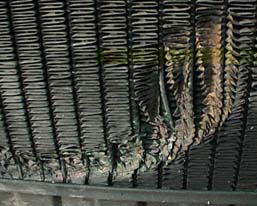
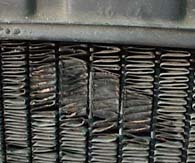
From the looks of these
pictures, I am really surprised I didn't have a massive coolant
leak. It looks like the fan had a rather close encounter with the
radiator. Oh well, chalk up something else that needs to be replaced.
BACK TO TOP
THE HEAD
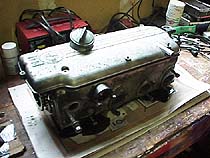
Here is the head sitting on my workbench. The head is an E12, which is "correct" for
a '73 2002 engine. However, a casting mark on the head seems to indicate that it was
manufactured in 1976. When I had a chance to examine it, I was shocked at the condition
of the second combustion chamber. Apparently, whatever it was that broke off of the
piston crown hammered the hell out of the chamber.
I took the head into a headshop,and the guy thought he could repair the damage by welding
it to build up material, then machining it back to shape. After measuring it, he
determined that it had been resurfaced in the past, and there wasn't enough deck material to
work with.I found another E12 head circa 1974 that was being used on a 1978 320i.
It was in excellent condition, and it too is in the shop. With parts from the two heads, the
machinist was able to build one good one.Since considerable headwork work needed to be done, I also picked up hotter camshaft.
I went with a Korman 300 camshaft along with rockers and springs to replace the stock
units.we'll see how this setup performs.
BACK TO TOP
THE CYLINDER




Overall, the cylinder walls look good - nothing that a pass of a honing machine won't take
care of. Since I have to replace the pistons, it may be worthwhile to get oversized pistons
and bore out the block anyway. One thing that is amazing to me is the lack of a ridge at
the top of the cylinder walls. Having opened up several domestic engines, there was always
a ridge. I was expecting one here as well
The #2 cylinder
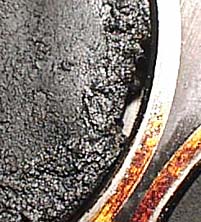
This is exactly what I saw when I peered down into cylinder #2. I saw something shiny inside
and thought, "what in the hell is that?"
BACK TO TOP
THE CRANKSHAFT

The crankshaft looks good as well. It appears there was good oil flow to all the bearings,
and none of the main bearings showed signs of overheating or scoring.
BACK TO TOP
THE PISTONS

Piston #1. It appears the free ends of the upper ring somehow overlapped,
jammed together then broke.

Piston #2. When I first looked down on piston #2 from the top I thought that the shiny
thing I was seeing in the crack was the top ring. It was actually the second ring that
I was seeing. The first ring is almost completely disintegrated.
Piston #3. I actually did not take a photo of piston #3 since it looked completely
normal. No wonder it still held 80 psi compression.

Piston #4. The cylinder having the lowest compression of all at 25 psi. The top ring
was broken in two places. One broken edge wore away the ring groove. On this side there
is small piece broken and wedged.
BACK TO TOP
THE ROD




Overall, the connecting rods look good. No visible cracks, or signs of overheating.
BACK TO TOP
BACK TO RESTORATION PROJECT HOMEPAGE


In November 1997, I pulled the engine and transmission together from the 2002. Not a difficult task at all, even for one person. While unbolting other stuff from the engine compartment, I noticed the radiator was in bad shape. Once out of the car, I separated the transmission and began dismantling the engine.
Once out of the car, I was able to clean and examine the outside of the block. A couple of things struck me as odd. First is that the head was an E12, which was not correct for a 49-state 1976 2002 (which this car is). The second was that the s/n of the block did not match the VIN on the car. After enlisting the help of 2002 email list members, I discovered that the engine is from a '73 2002, and not a '76. The E12 head, therefore is "correct" for this particular engine When I pulled the cylinder head off, I was able to look down the bores at the cylinder walls. They looked good, with no major scoring. However, I noticed something disturbing on cylinder #2. It appeared that a chunk of the piston crown was missing. You'll have to see the photos to fully appreciate the situation - it really is a visual.
BACK TO TOP
THE RADITOR



From the looks of these
pictures, I am really surprised I didn't have a massive coolant
leak. It looks like the fan had a rather close encounter with the
radiator. Oh well, chalk up something else that needs to be replaced.
BACK TO TOP
THE HEAD

Here is the head sitting on my workbench. The head is an E12, which is "correct" for
a '73 2002 engine. However, a casting mark on the head seems to indicate that it was
manufactured in 1976. When I had a chance to examine it, I was shocked at the condition
of the second combustion chamber. Apparently, whatever it was that broke off of the
piston crown hammered the hell out of the chamber.
I took the head into a headshop,and the guy thought he could repair the damage by welding
it to build up material, then machining it back to shape. After measuring it, he
determined that it had been resurfaced in the past, and there wasn't enough deck material to
work with.I found another E12 head circa 1974 that was being used on a 1978 320i.
It was in excellent condition, and it too is in the shop. With parts from the two heads, the
machinist was able to build one good one.Since considerable headwork work needed to be done, I also picked up hotter camshaft.
I went with a Korman 300 camshaft along with rockers and springs to replace the stock
units.we'll see how this setup performs.
BACK TO TOP
THE CYLINDER




Overall, the cylinder walls look good - nothing that a pass of a honing machine won't take
care of. Since I have to replace the pistons, it may be worthwhile to get oversized pistons
and bore out the block anyway. One thing that is amazing to me is the lack of a ridge at
the top of the cylinder walls. Having opened up several domestic engines, there was always
a ridge. I was expecting one here as well
The #2 cylinder

This is exactly what I saw when I peered down into cylinder #2. I saw something shiny inside
and thought, "what in the hell is that?"
BACK TO TOP
THE CRANKSHAFT

The crankshaft looks good as well. It appears there was good oil flow to all the bearings,
and none of the main bearings showed signs of overheating or scoring.
BACK TO TOP
THE PISTONS

Piston #1. It appears the free ends of the upper ring somehow overlapped,
jammed together then broke.

Piston #2. When I first looked down on piston #2 from the top I thought that the shiny
thing I was seeing in the crack was the top ring. It was actually the second ring that
I was seeing. The first ring is almost completely disintegrated.
Piston #3. I actually did not take a photo of piston #3 since it looked completely
normal. No wonder it still held 80 psi compression.

Piston #4. The cylinder having the lowest compression of all at 25 psi. The top ring
was broken in two places. One broken edge wore away the ring groove. On this side there
is small piece broken and wedged.
BACK TO TOP
THE ROD




Overall, the connecting rods look good. No visible cracks, or signs of overheating.
BACK TO TOP
BACK TO RESTORATION PROJECT HOMEPAGE



From the looks of these pictures, I am really surprised I didn't have a massive coolant leak. It looks like the fan had a rather close encounter with the radiator. Oh well, chalk up something else that needs to be replaced.
BACK TO TOP
THE HEAD

Here is the head sitting on my workbench. The head is an E12, which is "correct" for
a '73 2002 engine. However, a casting mark on the head seems to indicate that it was
manufactured in 1976. When I had a chance to examine it, I was shocked at the condition
of the second combustion chamber. Apparently, whatever it was that broke off of the
piston crown hammered the hell out of the chamber.
I took the head into a headshop,and the guy thought he could repair the damage by welding
it to build up material, then machining it back to shape. After measuring it, he
determined that it had been resurfaced in the past, and there wasn't enough deck material to
work with.I found another E12 head circa 1974 that was being used on a 1978 320i.
It was in excellent condition, and it too is in the shop. With parts from the two heads, the
machinist was able to build one good one.Since considerable headwork work needed to be done, I also picked up hotter camshaft.
I went with a Korman 300 camshaft along with rockers and springs to replace the stock
units.we'll see how this setup performs.
BACK TO TOP
THE CYLINDER




Overall, the cylinder walls look good - nothing that a pass of a honing machine won't take
care of. Since I have to replace the pistons, it may be worthwhile to get oversized pistons
and bore out the block anyway. One thing that is amazing to me is the lack of a ridge at
the top of the cylinder walls. Having opened up several domestic engines, there was always
a ridge. I was expecting one here as well
The #2 cylinder

This is exactly what I saw when I peered down into cylinder #2. I saw something shiny inside
and thought, "what in the hell is that?"
BACK TO TOP
THE CRANKSHAFT

The crankshaft looks good as well. It appears there was good oil flow to all the bearings,
and none of the main bearings showed signs of overheating or scoring.
BACK TO TOP
THE PISTONS

Piston #1. It appears the free ends of the upper ring somehow overlapped,
jammed together then broke.

Piston #2. When I first looked down on piston #2 from the top I thought that the shiny
thing I was seeing in the crack was the top ring. It was actually the second ring that
I was seeing. The first ring is almost completely disintegrated.
Piston #3. I actually did not take a photo of piston #3 since it looked completely
normal. No wonder it still held 80 psi compression.

Piston #4. The cylinder having the lowest compression of all at 25 psi. The top ring
was broken in two places. One broken edge wore away the ring groove. On this side there
is small piece broken and wedged.
BACK TO TOP
THE ROD




Overall, the connecting rods look good. No visible cracks, or signs of overheating.
BACK TO TOP
BACK TO RESTORATION PROJECT HOMEPAGE

Here is the head sitting on my workbench. The head is an E12, which is "correct" for a '73 2002 engine. However, a casting mark on the head seems to indicate that it was manufactured in 1976. When I had a chance to examine it, I was shocked at the condition of the second combustion chamber. Apparently, whatever it was that broke off of the piston crown hammered the hell out of the chamber.
I took the head into a headshop,and the guy thought he could repair the damage by welding it to build up material, then machining it back to shape. After measuring it, he determined that it had been resurfaced in the past, and there wasn't enough deck material to work with.I found another E12 head circa 1974 that was being used on a 1978 320i.
It was in excellent condition, and it too is in the shop. With parts from the two heads, the machinist was able to build one good one.Since considerable headwork work needed to be done, I also picked up hotter camshaft. I went with a Korman 300 camshaft along with rockers and springs to replace the stock units.we'll see how this setup performs.
BACK TO TOP
THE CYLINDER




Overall, the cylinder walls look good - nothing that a pass of a honing machine won't take
care of. Since I have to replace the pistons, it may be worthwhile to get oversized pistons
and bore out the block anyway. One thing that is amazing to me is the lack of a ridge at
the top of the cylinder walls. Having opened up several domestic engines, there was always
a ridge. I was expecting one here as well
The #2 cylinder

This is exactly what I saw when I peered down into cylinder #2. I saw something shiny inside
and thought, "what in the hell is that?"
BACK TO TOP
THE CRANKSHAFT

The crankshaft looks good as well. It appears there was good oil flow to all the bearings,
and none of the main bearings showed signs of overheating or scoring.
BACK TO TOP
THE PISTONS

Piston #1. It appears the free ends of the upper ring somehow overlapped,
jammed together then broke.

Piston #2. When I first looked down on piston #2 from the top I thought that the shiny
thing I was seeing in the crack was the top ring. It was actually the second ring that
I was seeing. The first ring is almost completely disintegrated.
Piston #3. I actually did not take a photo of piston #3 since it looked completely
normal. No wonder it still held 80 psi compression.

Piston #4. The cylinder having the lowest compression of all at 25 psi. The top ring
was broken in two places. One broken edge wore away the ring groove. On this side there
is small piece broken and wedged.
BACK TO TOP
THE ROD




Overall, the connecting rods look good. No visible cracks, or signs of overheating.
BACK TO TOP
BACK TO RESTORATION PROJECT HOMEPAGE




Overall, the cylinder walls look good - nothing that a pass of a honing machine won't take care of. Since I have to replace the pistons, it may be worthwhile to get oversized pistons and bore out the block anyway. One thing that is amazing to me is the lack of a ridge at the top of the cylinder walls. Having opened up several domestic engines, there was always a ridge. I was expecting one here as well
The #2 cylinder

This is exactly what I saw when I peered down into cylinder #2. I saw something shiny inside and thought, "what in the hell is that?"
BACK TO TOP
THE CRANKSHAFT

The crankshaft looks good as well. It appears there was good oil flow to all the bearings,
and none of the main bearings showed signs of overheating or scoring.
BACK TO TOP
THE PISTONS

Piston #1. It appears the free ends of the upper ring somehow overlapped,
jammed together then broke.

Piston #2. When I first looked down on piston #2 from the top I thought that the shiny
thing I was seeing in the crack was the top ring. It was actually the second ring that
I was seeing. The first ring is almost completely disintegrated.
Piston #3. I actually did not take a photo of piston #3 since it looked completely
normal. No wonder it still held 80 psi compression.

Piston #4. The cylinder having the lowest compression of all at 25 psi. The top ring
was broken in two places. One broken edge wore away the ring groove. On this side there
is small piece broken and wedged.
BACK TO TOP
THE ROD




Overall, the connecting rods look good. No visible cracks, or signs of overheating.
BACK TO TOP
BACK TO RESTORATION PROJECT HOMEPAGE

The crankshaft looks good as well. It appears there was good oil flow to all the bearings, and none of the main bearings showed signs of overheating or scoring.
BACK TO TOP
THE PISTONS

Piston #1. It appears the free ends of the upper ring somehow overlapped,
jammed together then broke.

Piston #2. When I first looked down on piston #2 from the top I thought that the shiny
thing I was seeing in the crack was the top ring. It was actually the second ring that
I was seeing. The first ring is almost completely disintegrated.
Piston #3. I actually did not take a photo of piston #3 since it looked completely
normal. No wonder it still held 80 psi compression.

Piston #4. The cylinder having the lowest compression of all at 25 psi. The top ring
was broken in two places. One broken edge wore away the ring groove. On this side there
is small piece broken and wedged.
BACK TO TOP
THE ROD




Overall, the connecting rods look good. No visible cracks, or signs of overheating.
BACK TO TOP
BACK TO RESTORATION PROJECT HOMEPAGE

Piston #1. It appears the free ends of the upper ring somehow overlapped, jammed together then broke.

Piston #2. When I first looked down on piston #2 from the top I thought that the shiny thing I was seeing in the crack was the top ring. It was actually the second ring that I was seeing. The first ring is almost completely disintegrated.
Piston #3. I actually did not take a photo of piston #3 since it looked completely normal. No wonder it still held 80 psi compression.

Piston #4. The cylinder having the lowest compression of all at 25 psi. The top ring was broken in two places. One broken edge wore away the ring groove. On this side there is small piece broken and wedged.
BACK TO TOP
THE ROD




Overall, the connecting rods look good. No visible cracks, or signs of overheating.
BACK TO TOP
BACK TO RESTORATION PROJECT HOMEPAGE




Overall, the connecting rods look good. No visible cracks, or signs of overheating.
BACK TO TOP
BACK TO RESTORATION PROJECT HOMEPAGE